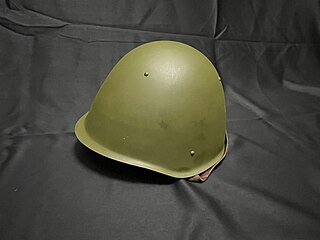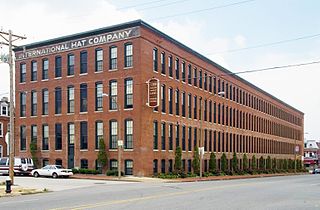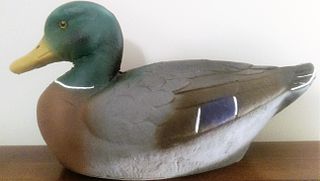
A hard hat is a type of helmet predominantly used in workplace environments such as industrial or construction sites to protect the head from injury due to falling objects, impact with other objects, debris, rain, and electric shock. Suspension bands inside the helmet spread the helmet's weight and the force of any impact over the top of the head. A suspension also provides space of approximately 30 mm between the helmet's shell and the wearer's head, so that if an object strikes the shell, the impact is less likely to be transmitted directly to the skull. Some helmet shells have a mid-line reinforcement ridge to improve impact resistance. The rock climbing helmet fulfills a very similar role in a different context and has a very similar design.

The Brodie helmet is a steel combat helmet designed and patented in London in 1915 by Latvian inventor John Leopold Brodie. A modified form of it became the Helmet, Steel, Mark I in Britain and the M1917 Helmet in the US. Colloquially, it was called the shrapnel helmet, battle bowler, Tommy helmet, tin hat, and in the United States the doughboy helmet. It was also known as the dishpan hat, tin pan hat, washbasin and Kelly helmet. The German Army called it the Salatschüssel. The term Brodie is often misused. It is correctly applied only to the original 1915 Brodie's Steel Helmet, War Office Pattern.

The Stahlhelm is a German military steel combat helmet intended to provide protection against shrapnels and fragments or shards of grenades. The term Stahlhelm refers both to a generic steel helmet and more specifically to the distinctive German military design.

The M1 helmet is a combat helmet that was used by the U.S. military from World War II until 1985, when it was succeeded by the PASGT helmet. The M1 helmet has become an icon of the US military, with its design inspiring other militaries around the world.

The pith helmet, also known as the safari helmet, salacot, sola topee, sun helmet, topee, and topi is a lightweight cloth-covered helmet made of sholapith. The pith helmet originates from the Spanish military adaptation of the native salakot headgear of the Philippines.

MartinLogan (ML) is a Canadian/US company producing conventional subwoofer speakers as well as floor-standing, wall-mounted, and in-wall hybrid speakers using electrostatic loudspeaker and planar magnetic thin film loudspeaker technology.

Jesse Barnum Hawley Jr. was an American football coach, inventor, and president of Hawley Products Company. He served as the head coach at the University of Iowa from 1910 to 1915 and at Dartmouth College from 1923 to 1928, compiling a career college football record of 63–28–1. Hawley was the tenth head coach in Iowa football history and led Dartmouth to a national championship in 1925. In 1935, Hawley invented a tropical shaped, pressed fiber sun helmet that was adopted in 1940 by the United States military. Approximately 250,000 of Hawley's military sun helmets were produced during World War II by Hawley Products Company and the International Hat Company.
The Air Motion Transformer (AMT) is a type of electroacoustic transducer. Invented by Oskar Heil (1908–1994), it operates on a different transduction principle from other loudspeaker designs, such as moving coil, planar magnetic or electrostatically-driven loudspeakers, and should not be confused with planar or true ribbon loudspeakers. In contrast to a planar ribbon loudspeaker, the diaphragm of the AMT is of pleated shape similar to a bellows. The AMT moves air laterally in a perpendicular motion using a metal-etched folded sheet made of polyethylene terephthalate (PET) film. The circuit path embossed on the PET membrane, acts as the voice coil unit. The diaphragm is then housed between 4 stacks of steel pole-plate pieces positioned at 45° within a high-intensity, quadratic, opposing magnetic field. The air motion transformer with its sheet film equally exposed at 180° behaves as a dipole speaker, exciting front and rear sonic waves simultaneously.
DESCO is an underwater diving equipment maker which was first organized in 1937 in Milwaukee, Wisconsin as Diving Equipment and Salvage Co.

The Mk III Helmet is a steel military combat helmet that was first developed for the British Army in 1941 by the Medical Research Council. They were issued to troops in April 1944 and then worn in combat for the first time by British and Canadian troops on D-Day. Mk III and Mk IV helmets were used alongside the Brodie helmet for the remainder of the Second World War. It is sometimes referred to as the "turtle" helmet by collectors, because of its vague resemblance to a turtle shell, as well as the 1944 pattern helmet.

The Bangtan Helmet is a combat helmet developed by South Korea in 1971. Despite the name, the helmet was not designed to withstand against direct hitting bullets but to protect against heavy objects and bomb shrapnel–a standard for 1970s military world wide; though, it was one of the earliest military helmets that applied non-metal composite material to reduce the weight while increasing the protection. The name was given as a commemorate for being superior than the M1 helmet. The helmet configuration is based on the latest version of the M1.
Emerson Knives, Inc. is an American company that produces knives and related products. It was founded in 1996 by custom knifemaker Ernest Emerson in an effort to mass-produce his folding knife designs for the U.S. Military and collector markets.

The M/1923 helmet was a combat helmet issued to Danish troops during the interwar period and saw service in the Second World War. It was the first helmet to be issued to the Royal Danish Army and Navy. The helmet was produced by the Danish company A/S Glud & Marstrands Fabrikker.

The SSh-68 - is a steel combat helmet of the Soviet and then Russian Armed Forces. The SSh-68 is a further development of the SSh-60 helmet. It differs primarily in its greater strength, greater front slope of the dome and the shorter outer edge. It is usually painted in dark green.

International Hat Company, formerly named the International Harvest Hat Company, was a St. Louis, Missouri-based manufacturer of commercial hats and military helmets. The company was one of the largest hat manufacturers in the United States and, at one time, the largest manufacturer of harvest hats in the world. It is best remembered for its design and mass production of tropical shaped, pressed fiber military sun helmets for service members of the United States Army, Marines, and Navy during and after World War II. Additionally, the American owned company was a major producer of harvest hats, straw hats, fiber sun hats, enameled dress hats, baseball caps, and earmuffs throughout most of the 20th century. However, it is the International Hat military sun helmets that have become the most notable collector's items.
Frank G. Pellegrino was an American engineer, inventor, and industrialist. He served as president of the General Fibre Company. During his tenure, General Fibre became the largest manufacturer of duck decoy models in the United States, producing over a million per year in the 1950s. Pellegrino also negotiated the sale of the International Hat Company to Interco, Inc. Additionally, he created a variety of inventions related to the plastic molding industry. Most notably, Pellegrino invented automated assembly line machines in the formation of plastic objects. These machines were used by General Fibre in the production of a variety of plastic models, duck decoys, and Michelob paraphernalia throughout the 1960s to 1980s.

General Fibre Company, also known as the General Moulding Company, was an American manufacturer of a wide variety of fiber and plastic molded products. The company was known for its popular Ariduk brand of duck and goose decoys. During World War II, in partnership with the International Hat Company, General Fibre was converted into a war factory for the production of military sun helmets. Conjointly, the companies were among the largest manufacturers and suppliers of American military pressed fiber sun helmets during World War II. In the post-war period, the company made an early entry into the emerging plastic injection molding industry, making the transition in material production from fiber to plastic goods. During the 1960s, the company designed and patented advances in methods of producing pulp articles in the plastics industry. Concurrently, General Fibre became a supplier to Ford Motor Company, in the manufacture of plastic interiors. The General Fibre Company closed in 1985.
George Tilles Jr. was president of the International Hat Company during World War II. Under Tilles, International Hat become one of the two dominant manufacturers of fiber pressed military pith helmets for the United States Army, Marines, and Navy. The Tilles Memorial City Park in Oran, Missouri, is named in his honor.

The American fiber helmet is a type of sun helmet made of pressed fiber material that has been used as part of the military uniform by various branches and units of the United States Armed Forces from 1934 to the present day. As of 2017, the helmet continues to be worn by U.S. military rifle range cadres, as an icon for marksmanship excellence. The helmet is technically not a pith helmet, insofar as it is not constructed from pith material. However, in the more generic sense of design style, this type of sun helmet is modeled similarly to one and thus often referred to in common use as a pith helmet. Additionally, the helmet is not a combat helmet, insofar as it was not originally designed to protect the head during combat. However, the helmet was nonetheless assigned, at various times in the 1930s and 1940s, as combat gear for use in active theaters.

The Gefechtshelm M92 is the standard issue combat helmet of the Bundeswehr, first fielded in 1992 as a replacement of earlier M1956 steel helmets that were previously used during the Cold War. It is made from Aramid composite materials and is used by all branches of the Bundeswehr.

















